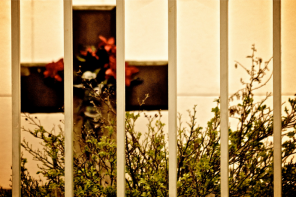Detainees in Guantanamo are not the only prisoners in US-run prisons on hunger strike. Nearly 7600 inmates in California prisons refused meals for the fifth day Friday to protest prison conditions and rules. Their five core demands center on California’s aggressive solitary confinement practices.
Over 80,000 people are held in solitary confinement in US prisons on any given day—12,000 of them in California.
California’s prisoners in solitary confinement spend 23 hours a day in Security Housing Units (SHUs)—small windowless concrete cells—with one hour in an exercise pen. Fluorescent lights in SHUs never shut off, reports Wired magazine, and video surveillance is constant. Some prisoners held in isolation are subjected to torture such as hog-tying, restraint chairs, and forced cell extraction, enduring sexual intimidation and violence, according to the American Friends Service Committee. They are cut off from communication with family and loved ones.
And solitary confinement is not limited to adults. Juveniles in the criminal justice system are subjected to it. As are those with mental illness. As are prisoners suspected of gang affiliation—or of having information about other people who might be in gangs.
Though solitary confinement is often described as a “tool of last resort,” a way to handle the “worst of the worst,” the sheer number of people being kept in solitary confinement and their length of time in isolation reveal otherwise.
“A common misperception is that inmates are places in solitary confinement as a result of a major incident of some kind and remain in solitary for perhaps 30 days,” Virginia Classick, the Vice President of the Board of Directors for the National Religious Campaign Against Torture, said when I spoke to her. “The reality is that in California, the average length of time in SHU is 6.7 years, with hundreds of inmates held in SHU for decades.”
Amnesty International reports that 78 people in California have spent over 20 years in solitary confinement.
The dramatic expansion of the US prison system over last 40 years—an expansion driven by the war on drugs and the privatization of the prison system that has incentivized locking more people up for longer periods of time—has been exceeded by the growth in the use of long-term solitary confinement, according to Laura Markle Downton, the Director of U.S. Prisons Policy & Program for NRCAT. Solitary confinement, she told me, has become a “default management tool.”
In 1985 there were a handful of control units across the country, according to the American Friends Service Committee. Today an estimated 44 states have supermax facilities, and “[as with the overall prison population, people of color are disproportionately represented in isolation units.”
“In California, roughly 90 percent of the individuals in the Security Housing Units are people of color,” said Markle Downton. “For people of faith, for people of conscience, the disproportionate impact on people of color further calls into question the use of this abusive practice.”
As the numbers have grown, so have the numbers of critics, Wired reports, citing a series of “scathing reports and documentaries” released in 2012 by the National Religious Campaign Against Torture, the New York Civil Liberties Union, the American Civil Liberties Union and Human Rights Watch, and Amnesty International. That same year, the US Senate held its first-ever hearings on solitary confinement. In May of 2013, according to Wired, “the US Government Accountability Office criticized the federal Bureau of Prisons for failing to consider what long-term solitary confinement did to prisoners.”
In 2011, the United Nations called on all countries to ban solitary confinement “except in very exceptional circumstances and for as short a time as possible, with an absolute prohibition in the case of juveniles and people with mental disabilities.”
“Segregation, isolation, separation, cellular, lockdown, Supermax, the hole, Secure Housing Unit… whatever the name, solitary confinement should be banned by States as a punishment or extortion technique,” said UN Special Rapporteur on torture Juan E. Méndez.
Méndez stated that keeping an adult in solitary confinement for longer than 15 days constitutes torture, but in US prisons, stays in solitary confinement often exceed years and turn into tens of years. “The reality is stunning,” says Markle Downton, “and it certainly helps to makes sense of why people who are incarcerated in California feel the situation is dire enough that it’s necessary to put their lives on the line to call for reform.”
The American Friends Service Committee (AFSC) has been working for decades to end solitary confinement, but according to AFSC’s Laura Magnani,
“This feels like a new moment because the prisoners themselves have stepped up and are taking the leadership in this movement, and it has made all the difference. There is much more awareness nationally and internationally about the problems of solitary confinement and why it constitutes torture.”
It’s not just the fact that this hunger strike might become the largest in the state’s history that matters, according to Magnani. “It’s the decision-making process,” she said. “It’s the fact that they’ve aligned themselves with nonviolent principles.”
“There is incredible resilience among survivors of solitary confinement who are engaged in work to bring the practice to an end,” said Markle Downton.
NRCAT offers practical tools for ending torture in US Prisons, including signing the national statement against prolonged solitary confinement. NRCAT and AFSC, as part of the Prisoner Hunger Strike Solidarity Coalition, are also in the process of releasing a letter for religious leaders to sign that is addressed to Governor Brown calling on him to honor the five core demands of the hunger strikers.
Why should religious communities stand in solidarity with the hunger strikers?
Markle Downton cited the common affirmation across faith traditions of the inherent dignity and worth of every person. “Subjecting people to harmful conditions is a violation of that inherent dignity,” she said.
“My faith tradition,” Classick said, “begins with the creation story in which God creates a companion, saying that humankind should not be alone. Prolonged, indefinite isolation is a profound violation of this central message in our earliest sacred story.”
At the end of our conversation, Markle Downton mentioned the Tamms Poetry Committee, a group of Chicago artists, poets, and magicians who created “Legislative Art” to educate the public about the terrors of Illinois’ Tamms supermax prison. Formed in 2010, this group first sent letters and poems to every person at Tamms to provide them with some social contact. According to the group, the replies demonstrated the necessity of the project: “Hi Committee, is this for real? I can’t believe someone cares enough to send a pick-me-up to the worst-of-the-worst. Well, if nobody else has said it, I will: THANK YOU.”
They quickly found themselves deluged with pleas for help: “Hey, this poetry is great, but could you please tell the governor what they’re doing to us down here?”
A detailed description of what they did next can be found here, but, as a professor at an art school, the part of their activism that caught my attention included “inviting the men of Tamms to request a single photograph of anything in the world—real or imagined.” The group then “connected with a network of photographers around the country who volunteered to fill the photo requests for the prisoners.”
You can see the photographs here, but here is a partial list of what the men requested:
My family together
My picture with blue sky
Downtown Chicago or Lake
Florida Beach Marriage Proposal Scene
Boy and Girl Playing Piano
Solitary confinement is by its very definition a practice meant to be hidden. People locked away, out of sight, in isolation. Hunger strikes, religion, and art have the power to bring such hidden practices to light. At their best, activism, art, and religion share common goals: to make visible the violence human beings do to one another; to disrupt the dehumanization that makes such violence possible (a dehumanization accomplished through words like “drug dealer” and “worst of the worst” and “prisoner” and “detainee” and “terrorist”); to begin to imagine that another world is possible; and to help bring that world into being—a world, in the words of my late mentor Gordon Kaufman, that is more just and life-giving for all.




